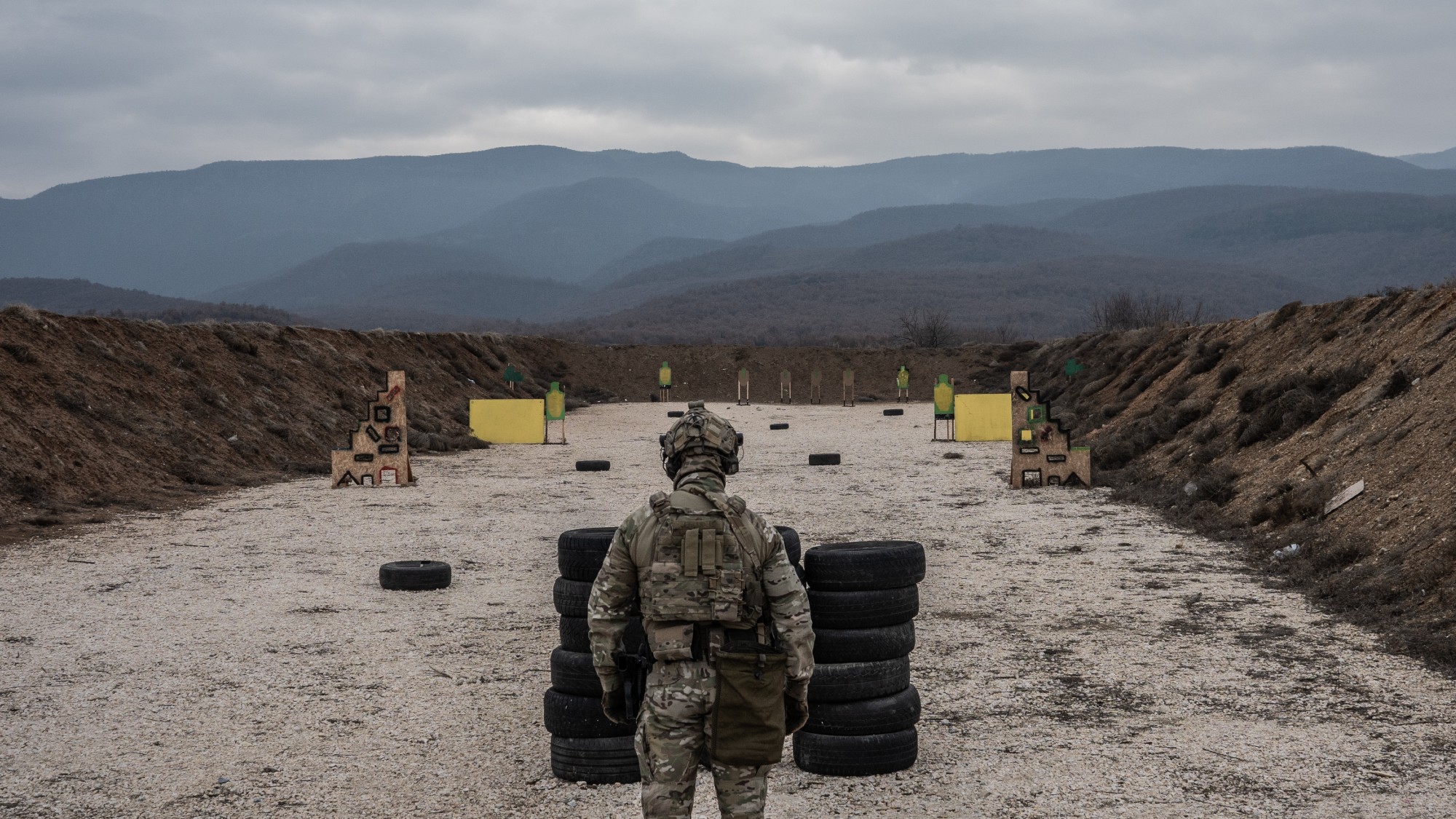AirAsia QZ8501: pilots 'turned off critical computer system'
Plane made steep climb to 37,400ft, above its authorised altitude, before plummeting into sea

The pilots of AirAsia flight QZ8501 are said to have turned off a key flight-protection system in the minutes before the aircraft crashed into the Java Sea.
All 162 people on board the flight were killed on 28 December, after it climbed so rapidly that it lost lift and began falling. A recording from the black boxes shows that warnings were blaring in the cockpit in the final moments of the flight.
According to two unnamed sources with "knowledge of the investigation", the pilots attempted to deal with the alerts before cutting power to the flight augmentation computers, which control the plane's rudder and prevent it from going too slowly.
The Week
Escape your echo chamber. Get the facts behind the news, plus analysis from multiple perspectives.

Sign up for The Week's Free Newsletters
From our morning news briefing to a weekly Good News Newsletter, get the best of The Week delivered directly to your inbox.
From our morning news briefing to a weekly Good News Newsletter, get the best of The Week delivered directly to your inbox.
They told Bloomberg that the pilots would then have been able to fly the plane manually. This explains how the flight-protection system could have been bypassed, but does not explain why the pilots then manually pulled the plane into such a steep climb, they said.
Officials have neither denied nor confirm the claims, explaining that they were still under investigation.
They did confirm, however, that the pilots had sought permission to climb from 32,000ft to 38,000ft because of storm clouds.
Air traffic control gave them permission to climb to 34,000ft, but the plane soared to 37,400ft, rising above the authorised altitude.
A free daily email with the biggest news stories of the day – and the best features from TheWeek.com
The aircraft climbed by more than 5,000ft in less than 30 seconds, before it descended slowly for three minutes and then disappeared.
The captain, who had more than 20,500 hours of flying experience, was said to have been monitoring the co-pilot, who was at the controls with at least 2,200 hours of experience.
"The pilots were conscious when the manoeuvre happened," said Ertata Lananggalih, an investigator with Indonesia's National Transportation Safety Committee. "They were trying to control the airplane."
The preliminary findings have been shared with countries involved in the investigation but have not been made public, as they are subject to change. Indonesian authorities have so far recovered at least 70 bodies.
AirAsia QZ8501: co-pilot at controls when plane crashed
29 January
The AirAsia plane that crashed last month in the Java Sea was being flown by its co-pilot when it went down, investigators have revealed.
Data from the plane's black box flight recorders indicate that the French first officer, Remi Plesel, rather than the captain, Iriyanto, was in charge of the plane when it went down.
“The second-in-command, popularly known as the co-pilot, who usually sits to the right of the cockpit – at the time, he was flying the plane,” chief investigator Mardjono Siswosuwarno told reporters in Jakarta.
However, Iriyanto had been supervising throughout the incident, Mardjono added.
Iriyanto, an Indonesian national, was "an experienced airman" who had been a fighter pilot before going into commercial aviation, the BBC reports.
At the time of the crash, he had logged 20,537 hours of flight time, 6,053 of which were with AirAsia. Plesel, a 46-year-old French national born in the Caribbean territory of Martinique, had 2,275 hours of flight experience.
Mardjono said that the plane was in good condition when it took off, adding that it flew at the correct altitude and that all the crew and cabin staff on board were properly certified. "The plane was flying before the incident within the limits of weight and balance envelope," Mardjono said. "Flight crew had valid licences and medical certificates."
Indonesian investigators submitted their preliminary report into the loss of the Airbus A320-200, which was carrying seven crew and 155 passengers, to the UN's International Civil Aviation Organisation this week.
According to their analysis, the plane climbed steeply just before the crash. In the space of 30 seconds, it gained 5,400 feet from its cruising altitude of 32,000 feet, the Daily Mail reports. It subsequently dipped back to 32,000 feet before descending for three minutes, until the black boxes stopped recording.
According to investigators, there was a group of large cumulonimbus clouds in the area at the time of the crash, but they declined to say whether pilots had flown into them. Cumulonimbus clouds can cause severe turbulence for aircraft, News.com.au reports.
AirAsia flight QZ8501: what did investigators learn from MH370?
23 January
The disappearance of AirAsia flight QZ8501 initially prompted comparisons to the case of Malaysia Airlines's missing flight MH370.
The two flights vanished within nine months of one another, with no final distress call nor immediate signs of wreckage. Both airlines have a Malaysian connection and were last seen on radar in the same region. But as debris from the AirAsia plane was swiftly located, crucial differences in the two tragedies emerged.
The MH370 disappearance is still largely a mystery, with investigators suspecting that the flight's transponder was deliberately switched off. It is believed to have ended up in an area of the Indian Ocean many times deeper than the Java Sea, where QZ8501 went down. MH370 disappeared in clear skies, while it appears that a storm contributed to QZ8501's demise.
So did the disappearance for MH370 teach the world any lessons?
Better communications
In the aftermath of MH370's disappearance, the airline and Malaysian officials were accused of releasing confusing and contradictory statements. Families of passengers and crew said their distress was compounded by the lack of reliable information. But [1]CNN says in the AirAsia case "both government and airline officials appear to be striking a more appropriate tone". Curt Lewis, an airline safety and accident investigation consultant, told Bloomberg the Indonesian government and AirAsia had responded more rapidly and with more accuracy to customers, families of victims and the media after learning "what not to do" from MH370.
Response time
Experts say Indonesia and AirAsia were also more open about asking for help from other countries, avoiding the pitfalls that hindered the response to the MH370 disaster. "The Indonesians seem to have reacted much quicker, with more zeal, and have been more welcoming of international support, than the Malaysians," said Richard Bitzinger, coordinator of the military transformations programme at the S Rajaratnam School of International Studies in Singapore.
Real-time tracking
After the loss of Air France flight 447 five years ago experts called for mandatory real-time tracking of commercial flights. This call was repeated last year after MH370 went missing. Even Malaysian Prime Minister Datuk Seri Najib Razak said the move was long overdue. "One of the most astonishing things about this tragedy is the revelation that an airliner the size of a Boeing 777 can vanish, almost without a trace," he said. But David Soucie, CNN safety analyst, says it is "incredibly painful" to see that the lessons were learned but not acted on in time to save the AirAsia flight.
Black box capability
One of the key differences between the two disappearances is the depth of water in which the planes are believed to have met their end. The water in the Java Sea where QZ8501 went missing is about 40 to 50 metres deep – a "stark difference" to the depths of more than 4,000 metres confronted by crews searching for MH370, says the Sydney Morning Herald. After MH370 there were calls for floating black boxes with a longer-range and longer-lasting signal. AirAsia's black boxes have been located, but experts pointed out that this might not have been the case if the plane had come down elsewhere.
AirAsia flight QZ8501: black box reveals final moments
22 January
The cockpit voice recorder from AirAsia flight QZ8501 has revealed that "screaming alarms" warned the pilots of immediate danger before the plane plunged into the Java Sea.
Several alarms can be heard going off "for some time" on the black box recording, drowning out the voices of the pilots, said an investigator from Indonesia's National Transportation Safety Committee (NTSC).
"The warning alarms, we can say, were screaming, while in the background they [the pilot and co-pilot] were busy trying to recover," he said.
According to the investigator, one of the alarms indicated that the plane was stalling.
The committee has ruled out the possibility of terrorism as a factor in the crash.
Flight QZ8501, which was en route from Surabaya in Indonesia to Singapore, crashed on 28 December, killing all 162 people on board. So far 53 bodies have been recovered, with divers struggling against rough seas and strong currents to reach the plane's main body on the seabed.
Earlier this week, Indonesia's transport minister, Ignasius Jonan, said that the flight had climbed dangerously fast before stalling and crashing into the sea. "In the final minutes, the plane climbed at a speed which was beyond normal," he said.
The NTSC is also examining the flight data recorder, which monitors every major part of the plane, with a preliminary report into the crash expected to be completed by next Tuesday.
All but seven of those on board the flight were Indonesian. The remaining victims were from South Korea, Singapore, Malaysia, Britain and France.
Daniel Tsang, founder of Hong Kong-based consultancy Aspire Aviation, told AFP that there were "striking" similarities to the Air France crash in 2009, when 228 people were killed.
Air France flight 447 vanished en route from Rio to Paris at night during a storm. An investigation found that its speed sensors had malfunctioned and the plane had climbed too steeply, causing it to stall.
-
 Is Europe finally taking the war to Russia?
Is Europe finally taking the war to Russia?Today's Big Question As Moscow’s drone buzzes and cyberattacks increase, European leaders are taking a more openly aggressive stance
-
 How coupling up became cringe
How coupling up became cringeTalking Point For some younger women, going out with a man – or worse, marrying one – is distinctly uncool
-
 The rapid-fire brilliance of Tom Stoppard
The rapid-fire brilliance of Tom StoppardIn the Spotlight The 88-year-old was a playwright of dazzling wit and complex ideas
-
 Femicide: Italy’s newest crime
Femicide: Italy’s newest crimeThe Explainer Landmark law to criminalise murder of a woman as an ‘act of hatred’ or ‘subjugation’ but critics say Italy is still deeply patriarchal
-
 Brazil’s Bolsonaro behind bars after appeals run out
Brazil’s Bolsonaro behind bars after appeals run outSpeed Read He will serve 27 years in prison
-
 Americans traveling abroad face renewed criticism in the Trump era
Americans traveling abroad face renewed criticism in the Trump eraThe Explainer Some of Trump’s behavior has Americans being questioned
-
 Nigeria confused by Trump invasion threat
Nigeria confused by Trump invasion threatSpeed Read Trump has claimed the country is persecuting Christians
-
 Sanae Takaichi: Japan’s Iron Lady set to be the country’s first woman prime minister
Sanae Takaichi: Japan’s Iron Lady set to be the country’s first woman prime ministerIn the Spotlight Takaichi is a member of Japan’s conservative, nationalist Liberal Democratic Party
-
 Russia is ‘helping China’ prepare for an invasion of Taiwan
Russia is ‘helping China’ prepare for an invasion of TaiwanIn the Spotlight Russia is reportedly allowing China access to military training
-
 Interpol arrests hundreds in Africa-wide sextortion crackdown
Interpol arrests hundreds in Africa-wide sextortion crackdownIN THE SPOTLIGHT A series of stings disrupts major cybercrime operations as law enforcement estimates millions in losses from schemes designed to prey on lonely users
-
 China is silently expanding its influence in American cities
China is silently expanding its influence in American citiesUnder the Radar New York City and San Francisco, among others, have reportedly been targeted